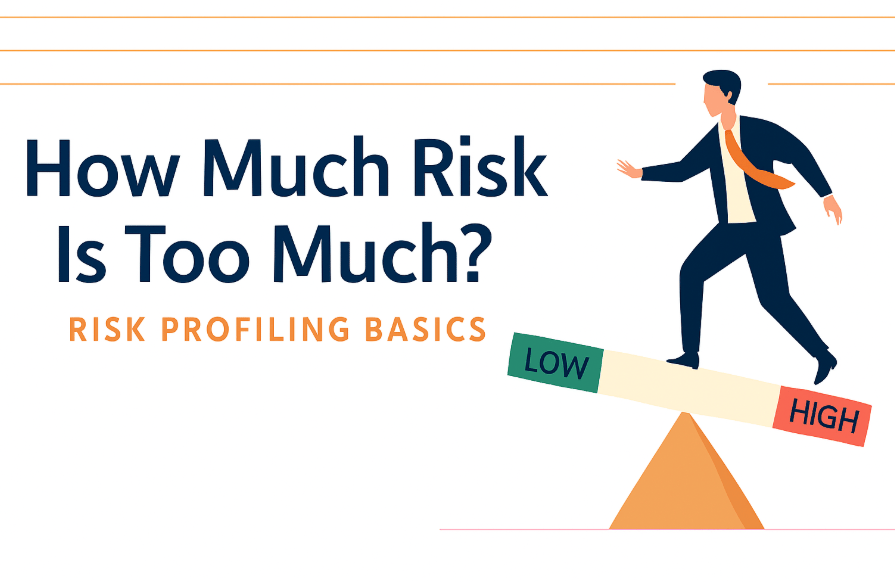- Live Life Grow Wealth
- Posts
- 🛡 Series 4 Day 3: How Much Risk Is Too Much? (Risk Profiling Basics)
🛡 Series 4 Day 3: How Much Risk Is Too Much? (Risk Profiling Basics)

Today’s Headline
🛡 Series 4: Risk Management & Protecting Your Wealth
Day 3: How Much Risk Is Too Much? (Risk Profiling Basics)
When I first started investing, I thought taking more risk meant making more money. The truth? That’s only half the story. Some people can handle big ups and downs without blinking an eye, while others lose sleep over a small dip in their portfolio. Knowing how much risk you can really handle — both emotionally and financially — is one of the most important steps in becoming a successful investor.
Risk profiling isn’t about making you timid or adventurous. It’s about understanding yourself. It helps you find the balance between earning good returns and sleeping peacefully at night. Because at the end of the day, an investment plan that you can’t stick with — no matter how smart it looks on paper — won’t work in real life.
“Want to Spot Financial Shifts Before the Market Does? Read This.”
Turn AI Into Your Income Stream
The AI economy is booming, and smart entrepreneurs are already profiting. Subscribe to Mindstream and get instant access to 200+ proven strategies to monetize AI tools like ChatGPT, Midjourney, and more. From content creation to automation services, discover actionable ways to build your AI-powered income. No coding required, just practical strategies that work.
💡 What Exactly Is “Risk” in Investing?
Risk simply means uncertainty — not knowing what will happen next. In investing, it’s the possibility that your investments might lose value.
But not all risks are bad. In fact, without risk, there would be no reward.
Here are a few types of risks investors face:
Market Risk – When the overall market drops, even good companies’ stock prices can fall.
Inflation Risk – When prices rise faster than your returns, your money loses value.
Interest Rate Risk – When rates go up, bond prices usually go down.
Liquidity Risk – When you can’t easily sell your investment without losing money.
Emotional Risk – The danger of making poor decisions driven by fear or greed.
When you understand these risks, you stop reacting emotionally and start thinking strategically. You begin to see that risk isn’t something to fear — it’s something to manage.
🎯 Why Risk Profiling Matters
Imagine two people:
Sarah is a calm long-term investor who doesn’t panic during market dips.
Tom can’t stand losing even $100 without getting anxious.
If both of them invest the same way, one will be miserable — and probably make bad decisions along the way.
That’s why risk profiling exists. It helps you:
Know your comfort zone.
Choose the right investment mix.
Avoid panic-selling during downturns.
Stay committed for the long run.
Think of it like getting fitted for a suit. You wouldn’t buy a “one-size-fits-all” suit for an important event. The same goes for your investment plan — it should be tailored to fit you.
🧭 The Three Pillars of Risk Profiling
When I guide people through risk profiling, I usually look at three key areas:
1. Financial Capacity
This is about your ability to take risks — how much loss you can afford before it affects your lifestyle.
It depends on:
Your income level
Savings and emergency fund
Debt obligations
Family responsibilities
For example, a young professional with a stable job and no dependents can generally take on more risk than a retiree who depends on their savings for daily expenses.
2. Emotional Tolerance
This is about your comfort with risk — how you feel about volatility.
Ask yourself:
How do I react when my investments drop 10%?
Do I get nervous when the market fluctuates?
Am I more afraid of losing money or missing out on gains?
Some people are naturally more adventurous, while others prefer steady growth. Neither is right or wrong — what matters is knowing which one you are.
3. Investment Goals
Your goals determine how much risk you need to take.
Short-term goals (like buying a house soon) usually require lower risk.
Long-term goals (like retirement or wealth building) can handle more volatility because time smooths out market fluctuations.
When these three areas — financial capacity, emotional tolerance, and investment goals — align, your portfolio will match your personality and lifestyle perfectly.
⚖️ The Risk Spectrum
Think of risk as a scale:
Conservative investors prefer stability and income. They invest more in bonds or savings products.
Balanced investors mix between stocks and bonds for moderate growth and protection.
Aggressive investors chase higher growth with more stocks, accepting short-term ups and downs.
The goal isn’t to be aggressive or conservative — it’s to be appropriate. The “right” level of risk is one you can live with for the long run.
🧩 How to Discover Your Risk Profile
There are a few ways to find your profile:
Risk Tolerance Questionnaires
These are short surveys that help you understand your comfort with risk. They ask questions like:“How would you react if your investment dropped 20%?”
“What’s more important to you — preserving capital or maximizing returns?”
Scenario Testing
Imagine your portfolio dropping in different market situations. Would you sell, hold, or buy more? Your reaction reveals your emotional tolerance.Review Your Past Behavior
Look back at your history. Did you panic during market crashes? Or did you stay calm? Your past reactions are great indicators of your risk tolerance.Professional Guidance
Sometimes, it helps to talk to a financial consultant. A professional can balance your emotions with your financial situation and give you objective feedback.
"Boost your investment strategy by unlocking the power of CTV advertising with Roku Ads Manager—learn how to maximize returns this holiday season. Click here to explore!"
It’s go-time for holiday campaigns
Roku Ads Manager makes it easy to extend your Q4 campaign to performance CTV.
You can:
Easily launch self-serve CTV ads
Repurpose your social content for TV
Drive purchases directly on-screen with shoppable ads
A/B test to discover your most effective offers
The holidays only come once a year. Get started now with a $500 ad credit when you spend your first $500 today with code: ROKUADS500. Terms apply.
🧠 Why Most People Misjudge Their Risk Tolerance
Here’s something I’ve noticed: people often think they’re comfortable with risk — until the market drops.
During good times, it’s easy to say, “I can handle volatility.” But when prices fall fast, emotions take over. Suddenly, risk feels very real.
This happens because of a psychological bias called loss aversion — we hate losing money more than we enjoy gaining it. Research shows that losing $100 feels twice as painful as gaining $100 feels good.
So, it’s not just about math — it’s about mindset. That’s why understanding your real tolerance before investing helps you avoid emotional mistakes later.
📉 What Happens When You Take Too Much Risk
Taking on too much risk can cause:
Panic-selling when markets fall
Poor timing decisions
Financial stress or sleepless nights
Abandoning your plan altogether
When emotions take control, even the best investment strategy can fail. You might sell at the bottom, buy at the top, and end up losing more than necessary.
Remember: Your portfolio should fit your emotions — not fight them.
📈 What Happens When You Take Too Little Risk
On the other hand, being too cautious also has risks.
If you keep all your money in low-yield assets like savings accounts or fixed deposits, inflation can quietly eat away your wealth.
Over time, that “safe” choice might make it harder to reach your goals.
For example, if your savings earn 2% but inflation is 4%, you’re actually losing purchasing power.
So, avoiding risk completely is also a form of risk — the risk of falling behind.
🛠 How to Adjust Your Risk Level
Here are some ways to keep your portfolio aligned with your comfort level:
Diversify Wisely – Spread your investments across asset classes, industries, and countries.
Set Stop-Loss or Rebalance Rules – Define how much loss you’re willing to tolerate before reviewing your portfolio.
Invest Gradually – If you’re nervous, use dollar-cost averaging to ease into the market.
Keep a Safety Net – Maintain an emergency fund so you don’t need to sell investments during downturns.
Review Annually – Your risk tolerance changes as your life changes — income, family, goals, and even age affect it.
💬 A Personal Reflection
I’ve met people who became overly aggressive after seeing others make quick money in the market. But when volatility hit, they couldn’t handle it and sold everything in fear.
Then I’ve also met those who were so afraid of losing that they never invested enough — and missed years of compounding growth.
Both extremes lead to frustration. The sweet spot is understanding yourself — and building a plan that supports who you are, not who you wish you were.
Final Takeaways
Managing risk is not about avoiding it — it’s about owning it.
When you know how much risk you can take and stick to it, you become a confident investor. You stop chasing returns or reacting to every headline.
Here’s what I want you to remember:
Risk is part of investing — but it doesn’t have to be scary.
Understanding your profile gives you clarity and control.
The goal isn’t the highest return — it’s consistent progress.
📣 Call to Action
If you haven’t already, take time today to reflect on your own risk profile.
Ask yourself — How much risk can I handle emotionally and financially?
Once you know that answer, you’ll be able to invest smarter, stay calmer, and grow your wealth with confidence.
Because investing isn’t about how fast you can grow — it’s about how long you can stay in the game.
[Live Life Grow Wealth]
🎓 Free Masterclasses to Unlock Your Investment Potential
Take your money skills to the next level with expert-led workshops designed to help you grow smarter and faster.
Recommendations Section
|
|
|
DISCLAIMER
I make no representations, warranties, or guarantees, whether expressed or implied, that the content provided is accurate, complete, or up-to-date. Past performance is not indicative nor a guarantee of future returns.
I am an individual content creator and not regulated or licensed by the Monetary Authority of Singapore (MAS) as I do not provide investment services.
All forms of investments carry risks, including the risk of losing your entire invested amount. Such activities may not be suitable for everyone. You are strongly encouraged to seek advice from a professional financial advisor if you have any doubts or concerns.









